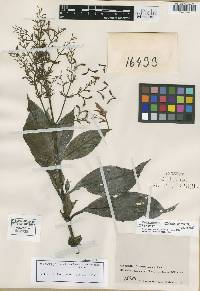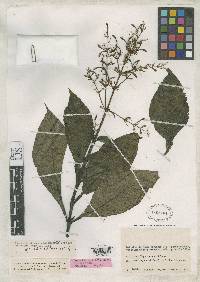
|
Family: Acanthaceae
|
Erect shrubby plants up to 1 meter high; stems quadrangular, more or less fleshy, glabrous or sparingly puberulous, the hairs variously curved, up to 0.24 mm. long; leaf blades oblong-elliptic, up to 15 cm. long and 6 cm. wide, short-acuminate (the tip itself blunt), narrowed at base and decurrent on the petiole, the uppermost leaves more or less auriculate at base, firm and fleshy, entire or undulate, the upper surface glabrous, the cystoliths minute, up to 0.1 mm. long, the lower surface glabrous except the costa and lateral veins (12 to 16 pairs), these sparingly puberulous or strigose, the hairs up to 0.32 mm. long, the cystoliths similar to those of the upper surface, the venation. prominent, the veinlets coarsely reticulate, the axils of the leaves often bearing small leafy shoots; petioles winged nearly to the base, glabrous or sparingly strigose; panicles terminal, up to 15 cm. long and broad, the nodes bearing 1 to several pairs of branches and sometimes ad- ditional sessile or subsessile flowers (flowering branches also occurring in the axils of the upper stem leaves); peduncles 5 cm. long, the lower- most internode 3 cm. long, the others successively shorter toward the tips of the branches, both peduncle and internodes of the inflorescence subquadrangular, striate, hirtellous, the hairs variously curved, spread- ing or ascending, up to 0.28 mm. long, septate, brownish; bracts sub- tending the lowermost branches of the inflorescence leaflike, about 2 cm. long and 5 mm. wide, those subtending the upper branches of the inflorescence linear, 10 mm. long and 0.75 mm. wide or smaller; bracts subtending the flowers triangular, 3 mm. long and 1.5 mm. wide at base, acute (the tip itself blunt), sparingly hirtellous and ciliate; bractlets linear, about 2.5 mm. long and 0.25 mm. wide, bluntish at tip, sparingly hirtellous; pedicels 5 to 7 mm. long, rather slender, puberulous, the hairs spreading or ascending, brownish, up to 0.16 mm. long; calyx 5 mm. long, the segments 5, narrowly triangular, 4 mm. long, 0.5 mm. wide at base, gradually narrowed to a slender tip, sparingly hirtellous, the hairs ascending, up to 0.13 mm. long; corollas up to 12 mm. long, lilac, rather sparingly puberulous, the hairs mostly spreading, up to 0.1 mm. long, some of them gland-tipped, the tube cylindric, 1.5 mm. in diameter, the lobes ovate, 4 to 5 mm. long, 2.5 to 3 mm. wide, subobtuse; stamens included, 3.25 mm. long, glabrous, the anthers 1.5 mm. long, 0.75 mm. wide near base, the lobes slightly divergent; staminodes about 1 mm. long, oblanceolate, glabrous; capsules clavate, about 18 mm. long, 4 mm. wide and 1.5 mm. thick, sparingly puberulous, the hairs mostly spreading, 0.1 mm. long, gland-tipped, the solid basal portion of the capsule slender, 12 mm. long, 1.5 mm. broad, 2 mm. thick; retinacula slender, 2.5 mm. long, curved, the tip rounded; seed suborbicular, 3 mm. long, 2.5 mm. wide and 0.5 mm. thick, brown, glabrous, bearing on the upper edge a crest of usually 7 triangular whitish spines, these about 0.75 mm. long, the anterior one multiple, and bearing also on the projecting basal edge a similar but shorter crest of 2 or 3 spines, all of the spines striate, whitish, broad-based, retrorsely hirtellous with rigid hairs about 0.02 mm. long. Type in the U. S. National Herbarium, No. 1852484, collected along the Río Calima at La Trojita, Department of El Valle, Colombia, 5-50 meters altitude, February 19 to March 10, 1944, by J. Cuatre- casas (No. 16433). Collected also in the same general region are the following: In dense forest along the Río Dagua, about 20 kilometers east of Buena- ventura, 40 meters altitude, February 15, 1939, E. P. Killip and Hernando Garcia, No. 33318 (US). Highway between Buenaventura and Cali at Km. 100, 100 meters altitude, December 5, 1946, Haught, No. 5323 (US). Wet forests of Chuare, Cauca, 90 meters altitude, December 24, 1946, Haught, No. 5390 (US). "Andes de Mariquita, Antioquia," 2,200 meters altitude, February 1852, Triana (K). According to the label notes, Haught's No. 5390 was taken from an epiphyte with very succulent shoots 1 meter long and having a showy purple inflorescence, and his No. 5323 was taken from an erect suffrutescent plant 1 meter high or less which possessed a showy inflorescence with the axes and flowers light purple. Killip and García describe their No. 33318 as an herb 80 cm. high, the stems in clusters bearing distichous panicles, and with both flowers and inflorescence branches pink. The type sheet bears the following note: "Sufrutex de ramas erguidas 1 m.; hojas rugosas, verde grisáceas; brácteas, cáliz y corola lilas." Pseuderanthemum ctenospermum can be easily recognized by its peculiar crested seed and rather large rugose leaves. This comblike crest suggests the specific epithet taken from the Greek comb, and seed. |







